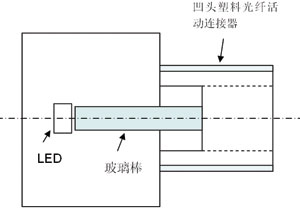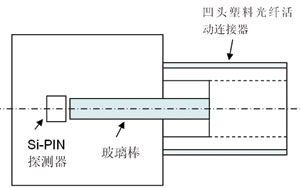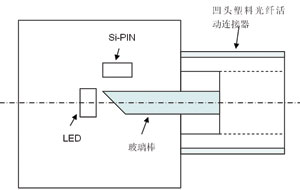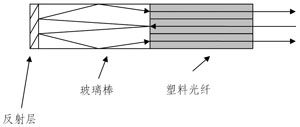Compared with cable, optical fiber has many advantages as a transmission medium, but quartz fiber used for ordinary communication is difficult to connect, expensive, and has high installation and maintenance costs. It cannot be widely used for short-distance data communication or desktop data connection. Plastic optical fiber not only has the advantages of optical fiber, but its diameter is generally 0.3 to 3mm. The large diameter is suitable for connection. The coupling efficiency of light is also high. At the same time, it also has flexibility, bending resistance, vibration resistance, radiation resistance, and low price. The advantages of convenient construction and so on can replace the traditional quartz optical fiber and copper cable to a certain extent. Therefore, the plastic optical fiber communication system is very suitable for short-distance (about 100m), small and medium-capacity (several Kb / s to 100Mb / s), low-cost (several tens of yuan) desktop data connection, and data between devices and the internal bus of the device connection.
Advantages of plastic optical fiber transmission system After the plastic optical fiber communication system is used to replace the cable connection, the performance of the equipment will be improved in the following aspects.
â— Improve the equipment's ability to resist electromagnetic interference and nuclear radiation.
â— No crosstalk. Use optical cable to transmit signals without crosstalk between signals.
â— Reduce the weight of the system. The weight of a 1500m diameter 1mm plastic optical fiber is less than 2kg.
â— Strong anti-lightning ability. The metal-free optical cable itself is a good insulator, even if it is exposed outdoors, it will not cause lightning damage to the equipment.
Plastic optical fiber communication system description The basic components of a plastic optical fiber communication system are: optical transmitter, optical receiver, plastic optical fiber and some passive devices. The optical transmitter converts electrical signals (such as TTL level signals) into optical signals. The optical signals are coupled into the plastic optical fiber and transmitted to the optical receiver through the plastic optical fiber. The optical receiver restores the optical signal to the electrical signal (such as TTL Level signal).
The plastic optical fiber communication system focuses on short-distance communication, low cost, simple and easy to operate, and high reliability. Therefore, the specific system implementation is completely different from the quartz optical fiber communication system.
1 Plastic optical fiber communication transceiver The plastic optical fiber communication transceiver is the core part of the plastic optical fiber communication system, including the optical transmitter and the optical receiver.
Figure 1 is a schematic diagram of the structure of the optical transmitter. The light-emitting diode (LED) is a high-brightness surface-mount light-emitting diode for general display. The drive current is less than 20mA and the center wavelength is 590nm (orange-yellow light). The reason why the light-emitting diode of 590nm is selected is because the light-emitting diode of this wavelength is very cheap, and at the wavelength of 590nm, the loss value of the plastic optical fiber is relatively low. The size of the LED chip is about 1.0mm × 1.0mm, which is equivalent to the diameter of the plastic optical fiber, and it is easy to couple the optical signal into the plastic optical fiber.

Figure 1 is a schematic diagram of the structure of the optical transmitter
The externally input TTL level signal is FSK tuned, and the TTL level signal is converted into a carrier signal more suitable for plastic optical fiber transmission to drive the LED to emit light. The optical signal output by the light emitting diode (LED) is directly coupled into a glass rod with a diameter of 1.0 mm, and then coupled into a plastic optical fiber with a diameter of 1.0 mm through the glass rod.
Figure 2 is a schematic diagram of the structure of the optical receiver. The optical detector detects the optical signal and generates an induced current, which is then amplified by the amplifier module in two stages and input to the FSK demodulation module for demodulation by a trigger. The demodulated signal still contains high-frequency interference. After being filtered by the filter module, the decision module makes a decision to restore the input TTL signal.

Figure 2 Schematic diagram of the optical receiver
The above two plastic optical fiber transceiver solutions are for point-to-point connection applications. The transceiver of the bus type plastic optical fiber communication system should be a bus type. In the photoelectric conversion, the bus type plastic optical fiber communication transceiver is the same as the point-to-point type plastic optical fiber communication transceiver, but the bus type plastic optical fiber communication transceiver is half-duplex It works in a way that it has only one optical signal input and output port, or it has only one female plastic optical fiber connector with a concave head. At this time, in the female plastic optical fiber connector with a concave head, the glass rod connected to the LED and Si-PIN The end face is not vertical, but 45 ° sloped, so that the beam can be divided into two, all the way to Si-PIN, all the way to the LED. Figure 3 is a schematic diagram of a bus-type plastic optical fiber communication transceiver.

Figure 3 Bus-type plastic optical fiber communication transceiver
2 Plastic optical fiber active connector The plastic optical fiber active connector is used to connect the plastic optical fiber transceiver and the plastic optical fiber, through which it couples the optical signal into the plastic optical fiber. Similar to cable connectors, it is divided into concave and convex structures. The female plastic optical fiber connector and the plastic optical fiber communication transceiver are integrated, and the male plastic optical fiber connector is connected to the plastic optical fiber.
There are many options for the mechanical structure of plastic optical fiber connectors. Because the diameter of plastic optical fiber cores is large, plastic optical fiber connectors can be completely different from the commonly used quartz optical fiber connectors, which can be modeled on the structure of current cable connectors ( Such as SMA structure), not only to achieve low connection loss, but also to use wire clamps and electrician blades, it is convenient to complete the assembly of plastic optical fiber movable connector parts on site.
3 Plastic optical fiber fixed connector The plastic optical fiber fixed connector is used to connect plastic optical fiber and plastic optical fiber. Using the V-groove structure, two plastic optical fibers are placed in the V-groove, and the plastic optical fiber is fixed with a metal material, and then sealed with a heat shrinkable tube to complete the production of a plastic optical fiber fixed connector. The V-groove structure can achieve the purpose of making plastic optical fiber fixed connectors quickly and easily. At the same time, due to the large diameter of the plastic optical fiber (1mm), the connection loss will not be large.
4 Plastic optical fiber bus splitter Plastic optical fiber bus splitter is used for bus-type plastic optical fiber communication system. As shown in Figure 4, the optical input signal of any port is evenly distributed to the other ports after the total reflection of the glass rod and the reflection of the end surface of the glass rod. The requirements for the plastic optical fiber bus splitter are first, low additional loss, second, good uniformity of each port, and third, simple structure and low cost.

Figure 4 Plastic optical fiber bus splitter
5 Plastic optical fiber optical multimeter Plastic optical fiber optical multimeter consists of a light source, an optical power meter, a microprocessor and a liquid crystal display. Using LED as the light source and Si-PIN as the detector. It is similar to the commonly used fiber optic multimeter at present, except that the wavelength range of the light used is different, and the cost is also different.
Key technology
1 Low-cost plastic optical fiber communication transceiver The plastic optical fiber communication transceiver should be a high-sensitivity, bursty receiver and an extremely low-cost optical fiber transceiver. The principle of the plastic optical fiber communication transceiver is relatively simple, but at the same time it requires extremely low circuit cost, it must also ensure high reception sensitivity, high reliability, and small size. At present, the system has achieved a transmitting sensitivity of -10dBm at the sending end and a receiving sensitivity of -40dBm at the receiving end (10E-9 bit error rate).
2 Plastic optical fiber movable connector The key technology of the plastic optical fiber movable connector is that it is simple to manufacture and low in cost. You can use simple tools such as clamps and electrical blades to easily complete the assembly of the plastic optical fiber movable connector parts on site. The connection loss should be less than 1dB.
3 plastic optical fiber bus splitter The plastic optical fiber bus splitter is a key device to realize the bus-type plastic optical fiber communication system. The optical input signal of any port is evenly distributed to other ports.
It looks like the 1 × N optical splitter commonly used now, but in fact the principle and function are different. 1 × N optical splitter is to distribute the optical input signal of one port to other ports evenly, or to collect the optical input signals of N ports to a port; plastic optical fiber bus splitter requires any one port The optical input signal is evenly distributed to other ports. It is a half-duplex device. When the bus-type plastic optical fiber communication system is working normally, only one port has an optical signal output, and the remaining ports are input optical signals. It is used in conjunction with a bus-type plastic optical fiber transceiver to form a bus-type plastic optical fiber communication system. It not only requires simple structure, but also requires low cost.
High Efficient Freight Elevator
Vertical Cargo Lift,Portable Elevator,Hydraulic Cargo Lift,Outdoor Freight Elevator
XI'AN TYPICAL ELEVATOR CO., LTD , https://www.chinaxiantypical.com